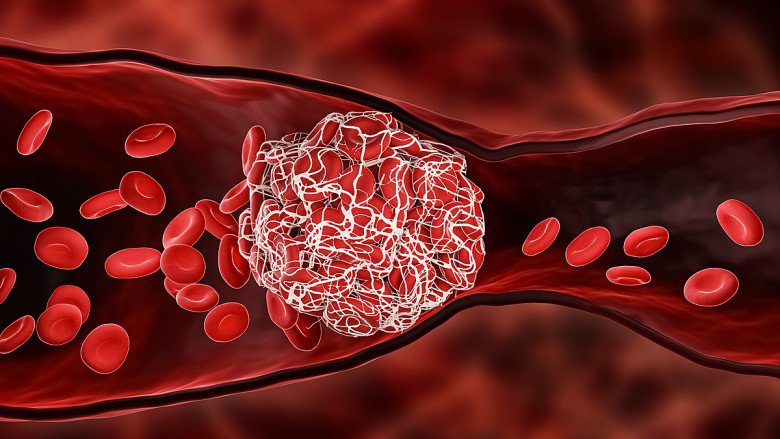Figures from the US Centers for Disease Control and Prevention (CDC) show that more than 795,000 people in the US have a stroke each year, about 610,000 of whom have a first stroke.
In 2019, stroke was the second leading cause of death globally, accounting for 11% of all deaths.
There are three main types of stroke. The first and most common, accounting for 87% of cases, is ischemic stroke. This occurs when blood flow through the arteries that supply oxygen to the brain is blocked.
The second type is hemorrhagic stroke, which occurs when an artery in the brain bursts, damaging the surrounding tissue.
The third type is a transient ischemic attack (TIA), which occurs when blood flow to the brain is temporarily blocked, usually for no more than 5 minutes.
Brain ischemia is the cause of stroke. Illustration
While strokes are increasingly common, many people still misunderstand the disease. Dr. Rafael Alexander Ortiz, head of the Department of Endovascular Surgery and Interventional Neuroradiology at Lenox Hill Hospital (USA), points out 6 major misconceptions about stroke that many of us tend to make.
Myth 1: Stroke is caused by heart problems
Although stroke risk is related to cardiovascular risk factors, stroke actually occurs in the brain, not the heart.
“Some people think stroke is a heart problem, that’s not true. A stroke is a brain problem, caused by a blockage or rupture of an artery or vein in the brain, not the heart, explains Dr Ortiz. .
Myth 2: It’s impossible to prevent stroke
This misunderstanding is very common. However, Dr Ortiz said: “The most common risk factors for stroke include high blood pressure, smoking, high cholesterol, obesity, diabetes, head or neck injury and heart arrhythmias.
Most of these risk factors can be prevented by an active lifestyle. Regular exercise and healthy eating can help reduce risk factors such as high blood pressure, high cholesterol, obesity, and diabetes… Reducing alcohol consumption and reducing stress can also help significantly reduce the risk of stroke.

Many strokes can be prevented with healthy living habits. Illustration
Myth 3: Stroke is not a hereditary disease
Single gene disorders (eg, sickle cell disease) increase the risk of stroke. This is closely related to heredity. In addition, other genetic factors such as high blood pressure, cardiovascular risk… can also indirectly increase the risk of stroke.
Due to environmental and lifestyle influences, unhealthy factors in the family tend to increase the risk of stroke in family members, especially when combined with genetic risk factors.
Myth 4: Symptoms of a stroke are hard to spot
The most common stroke symptoms are summarized in the word FAST.
F (Face): The face sag, one side of the face becomes numb, causing the mouth to smile.
A (Arm – arm): One arm is weak, numb, even hangs when lowered.
S (Speech): Difficulty speaking, even stuttering.
T (Time): Time to call an ambulance.
Some of the other symptoms of a stroke include: Weakness in one arm, leg, trunk, difficulty seeing with both eyes, difficulty walking due to dizziness, loss of balance, severe headache. ..
Myth 5: Untreatable stroke
Ortiz explained, many people believe that stroke cannot be cured. However, that was a misunderstanding. According to Dr., emergency stroke treatment with injections to dissolve blood clots, minimally invasive mechanical thrombolysis to remove blood clots or surgery can reverse stroke symptoms in many patients, especially when they arrive at the hospital immediately – that is, within minutes or hours of symptoms. first appeared. The longer it is left, the lower the chances of a good treatment outcome.
The results showed that people who went to the emergency room within 3 hours of the first symptoms were less likely to be disabled than those who arrived later.
Myth 6: Strokes only happen to older people

More and more young people are having strokes. Illustration
Age is a significant risk factor for stroke. The risk of stroke doubles every 10 years, after age 55. However, strokes can occur at any age. The results of the health data collection show that 34% of stroke hospitalizations in 2009 were under 65 years of age. A 2013 study found that about 15% of people with ischemic stroke are in their teens and twenties.
Stroke risk factors including hypertension, diabetes, obesity, dyslipidemia, and tobacco use were some of the most common conditions in this age group, the researchers noted.
Myth 7: Every stroke has symptoms
Not every stroke has symptoms. Several studies have shown that asymptomatic strokes are much more common than symptomatic cases. One study found that, of the more than 11 million strokes in 1998, 770,000 had symptoms, while nearly 11 million did not. The evidence for this silent stroke has only been found through MRI scans, which show signs as white spots of scar tissue after a blockage or rupture of a blood vessel in the brain.
Myth 8: Temporary strokes are not scary
According to Dr. Ortiz, a temporary stroke is as dangerous as a stroke, because it is a sign of a major stroke. Therefore, when experiencing acute stroke symptoms, even temporary, it must be treated and handled directly to prevent further consequences.
Myth 9: Stroke always paralyzes
Stroke is a major cause of long-term disability, but not everyone who has a stroke becomes disabled, paralyzed or weakened. Statistics show that stroke causes reduced mobility in more than half of stroke survivors aged 65 years and over.
The paralysis of stroke patients depends on many factors, such as the amount of brain tissue affected and the area affected. For example, damage to the left brain will affect the right side of the body and vice versa.
In case of stroke caused by problems of the left brain, the body may be paralyzed on the right side, have problems with communication, slow behavior, memory loss… In case of stroke caused by problems of problems of the right brain, the patient may experience vision problems, loss of memory…
Myth 10: The recovery process from a stroke goes smoothly
Recovery from a stroke can take months, if not years. However, many people may not fully recover. Of those who have had a stroke, only about 10% make a full recovery, 10% require long-term care, while 25% recover with mild disability, the remaining 40% have moderate to severe impairment.
at Blogtuan.info – Source: Eva.vn – Read the original article here





